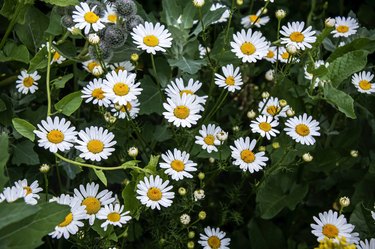
A list of spring flowers may not include many German flowers. Although many are revered for their beauty, they are not as commonly known in the U.S. For example, the vibrant blue cornflower (Centaurea cyanus, USDA hardiness zones 2 to 11) is the country's national flower and is native to Europe. There are other German flowers that are worth learning about as well.
German Flowers: Edelweiss
Video of the Day
The most iconic German flower is probably edelweiss (Leontopodium alpinum, USDA hardiness zones 4 to 9). The word edelweiss is a combination of two German words that mean "noble" and "white." Of course, had it not been the subject of a beloved song of the same name in "The Sound of Music," you might have never heard of it.
Video of the Day
Edelweiss grows higher than 10,000 feet above sea level, so it requires some effort to get to these lovely blooms. An 1861 book called "Edelweiss," written by Berthold Auerbach, described how the hero risks his life to gather the rare flower for his beloved. Legend also holds that German troops searched for these flowers high in the Alps, picking them from perilous cliffs to display the soldiers' valour and bravery as warriors. To this day, edelweiss signifies true and eternal love.
According to experts, edelweiss is a small perennial plant, with furry, silverish leaves and small white flowers that sit flat against the leaves. Each can grow from 4- to 16-inches tall, and can spread out to 8 inches by 8 inches. They originated in the European Alps and look like snowflakes when they bloom in the spring.
Other German Flowers
Other popular German flowers include the snowdrop (Galanthus nivalis, USDA hardiness zones 3 to 7). These perennials grow from bulbs and are less than 1-foot tall. The white flowers present themselves from February to March, growing best in partially shaded locations and well-draining, moist soil.
The grape hyacinth (Muscari armeniacum, USDA hardiness zones 4 to 8) blooms a bit later, in April, with conical racemes that have urn-shaped, white-edged, deep violet-blue flowers. They are often compared to upside-down bunches of grapes, and the green leaves below can stretch out to 12-inches long. These perennials are easy to grow from bulbs as long as they are planted in full sun to partial shade in well-draining, moderately moist soil.
Another popular choice, the German chamomile (Matricaria chamomilla, USDA hardiness zones 5 to 8), is a native German plant that thrives in North America. Even though it is an herb, this annual produces pretty, little, daisy-like flowers. It can grow up to 2 feet tall in light, well-draining sandy soil in full sun or light shade.
Favorite Spring Flowers
The daffodil (Narcissus pseudonarcissus, USDA hardiness zones 3 to 8) can also be considered a German flower; even though it is not native to Europe, it is widely grown and appreciated in Germany. These lovely flowers are viewed by many gardeners as one of the first harbingers of spring, with large, bell-shaped, six-petaled blooms. You can find them in many single colors and color combinations, including yellow, pink, orange, or white and yellow.
Tulips (Tulipa spp., USDA hardiness zones 3 to 8) are another perennial bulb associated with springtime, with their bluish-green leaves and bright cup-shaped flowers that range from white to red to multi-colored. Like daffodils, tulip bulbs should be planted in the fall before the first freeze. They can grow up to 2 feet high, with one flower per stem.